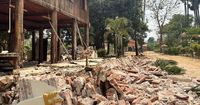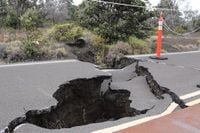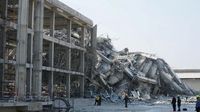A powerful 7.7 magnitude earthquake struck central Myanmar on March 28, 2025, sending shockwaves across Southeast Asia and causing significant damage in both Myanmar and neighboring Thailand. The earthquake, which occurred at 12:50 PM local time, was centered near Mandalay, Myanmar’s second-largest city, located approximately 17.2 kilometers from the epicenter at a shallow depth of just 10 kilometers. The tremors were felt as far away as Bangkok, Thailand, and even in parts of Vietnam and China.
The seismic event was followed by a strong aftershock measuring 6.4, further rattling the region. Reports indicate that at least 13 people were confirmed dead in Myanmar, while three fatalities occurred in Thailand due to a building collapse in Bangkok. The quake's impact was profound, with extensive damage to infrastructure, including the collapse of a 30-story skyscraper under construction in Bangkok, which trapped dozens of workers.
In Mandalay, the earthquake resulted in substantial destruction, with collapsed buildings and severe damage reported throughout the city. Eyewitness accounts describe chaotic scenes as residents rushed out of their homes and offices, fearing aftershocks. "We all ran out of the house as everything started shaking. I witnessed a five-storey building collapse in front of my eyes," a local resident recounted. Social media posts showed images of debris littering the streets and deep cracks in roadways.
Authorities in Myanmar are still assessing the full extent of the damage, which includes the collapse of bridges and several structures across the Sagaing region. In Naypyidaw, the capital, religious shrines were damaged, and parts of homes were reported to have fallen. The Myanmar Fire Services Department is actively conducting search and rescue operations, but the ongoing civil unrest in the country complicates the response efforts.
Meanwhile, in Bangkok, the earthquake prompted a swift emergency response. Prime Minister Paetongtarn Shinawatra declared the city a disaster area, allowing for interagency aid and emergency assistance. Panic ensued as alarms went off in high-rise buildings, and residents evacuated to the streets. "All of a sudden, the whole building began to move. Immediately there was screaming and a lot of panic," said Fraser Morton, a tourist who experienced the quake while shopping in a mall.
The collapse of the skyscraper in Bangkok, which was intended to house government offices, resulted in three confirmed deaths and left dozens of workers trapped under the rubble. Rescue operations were underway, and video footage captured the dramatic moments of the building's failure, with onlookers fleeing in terror.
In addition to the immediate casualties, the earthquake has raised concerns about structural integrity in both Myanmar and Thailand. The elevated rapid transit system and subway in Bangkok were temporarily shut down as a precaution, while trading on the Stock Exchange of Thailand was halted for the afternoon session. The tremors were felt across nearly all regions of Thailand, with reports of water sloshing from rooftop pools and debris falling from buildings.
As the region grapples with the aftermath of the earthquake, the tourism industry is bracing for a wave of cancellations. March marks a peak travel period for Southeast Asia, and major tour operators are already reporting a spike in cancellations, particularly for itineraries involving Myanmar. Tour operators in popular destinations like Bagan and Inle Lake are assessing the safety of their operations and rerouting tours to less affected areas.
In neighboring China, strong tremors were reported in the Yunnan province, with damage and injuries noted in Ruili, a city near the Myanmar border. Residents described the intense shaking, with some unable to stand. Videos from the area showed debris littering the streets and buildings swaying dangerously.
The earthquake serves as a stark reminder of the region's vulnerability to natural disasters. While Southeast Asia is no stranger to seismic activity, the psychological impact of such events can be profound, especially for tourists already wary from recent political unrest and natural calamities. Authorities in both Myanmar and Thailand are now faced with the dual challenge of ensuring public safety and restoring confidence in their tourism sectors.
As the situation continues to develop, emergency travel advisories are expected to be updated by various governments, including the U.S. State Department and those of Canada, Australia, and the European Union. Travelers planning to visit the region are advised to stay informed and consider the potential risks associated with travel in the aftermath of such a significant earthquake.
In conclusion, the March 28 earthquake has not only caused immediate destruction and loss of life but also poses long-term challenges for recovery and rebuilding in both Myanmar and Thailand. The focus will now shift to assessing damage, providing aid, and ensuring the safety of residents and tourists alike in the coming days and weeks.








